高中英语作文素材积累 Hello.China(中国文化)课件(共40张PPT)
文档属性
| 名称 | 高中英语作文素材积累 Hello.China(中国文化)课件(共40张PPT) | 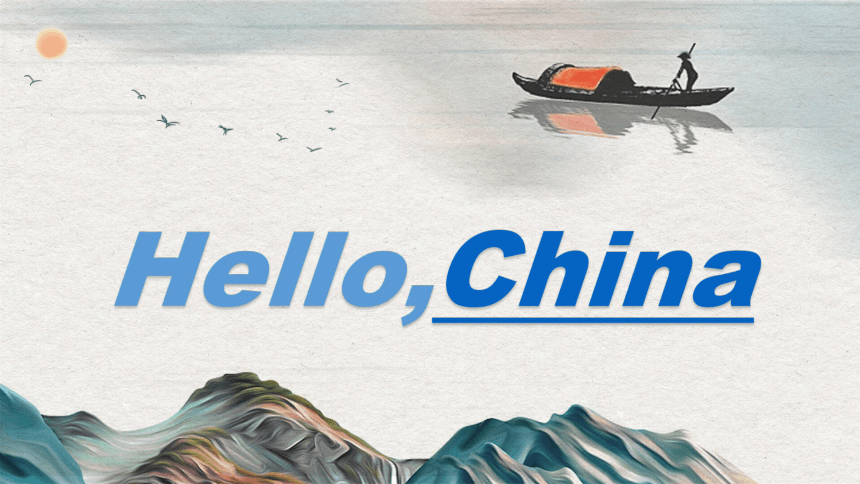 | |
| 格式 | pptx | ||
| 文件大小 | 90.0MB | ||
| 资源类型 | 教案 | ||
| 版本资源 | 通用版 | ||
| 科目 | 英语 | ||
| 更新时间 | 2025-04-05 15:51:50 | ||
图片预览

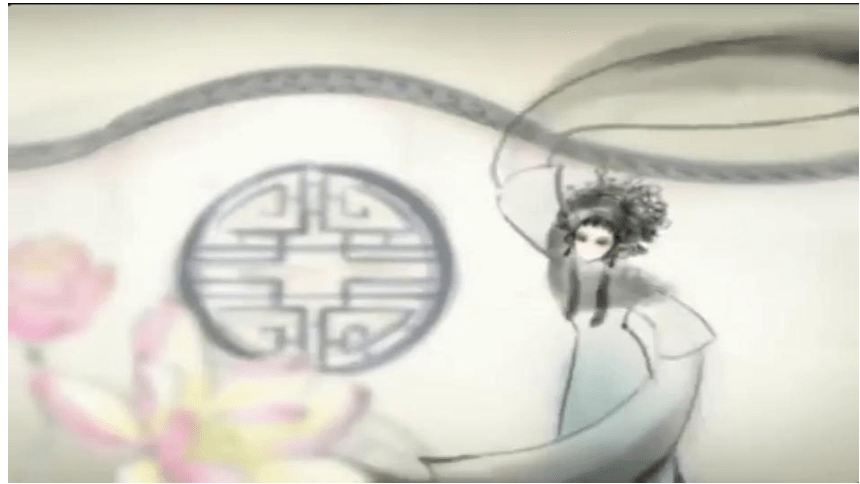
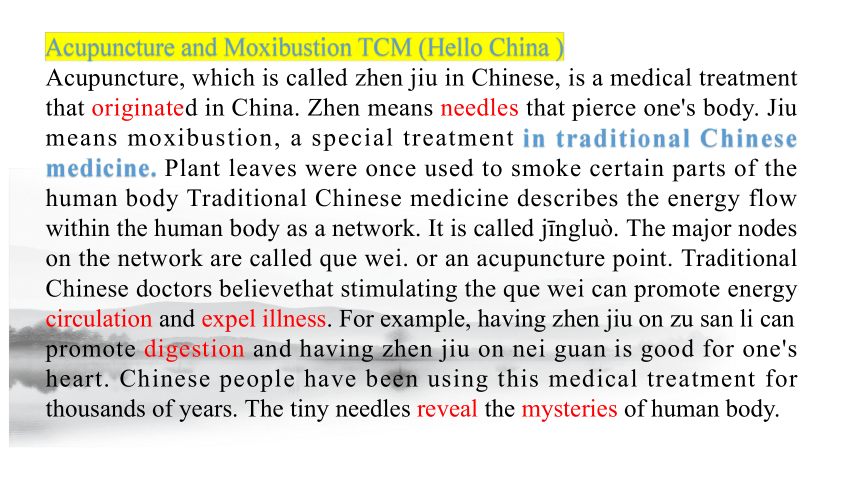
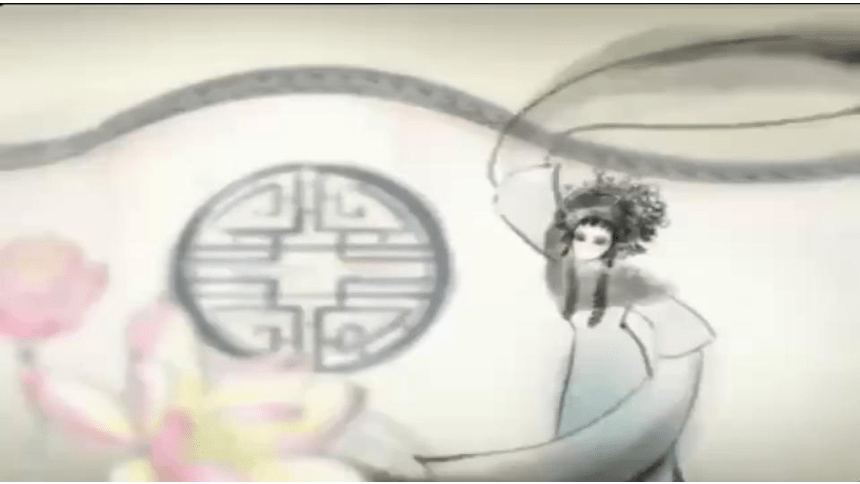
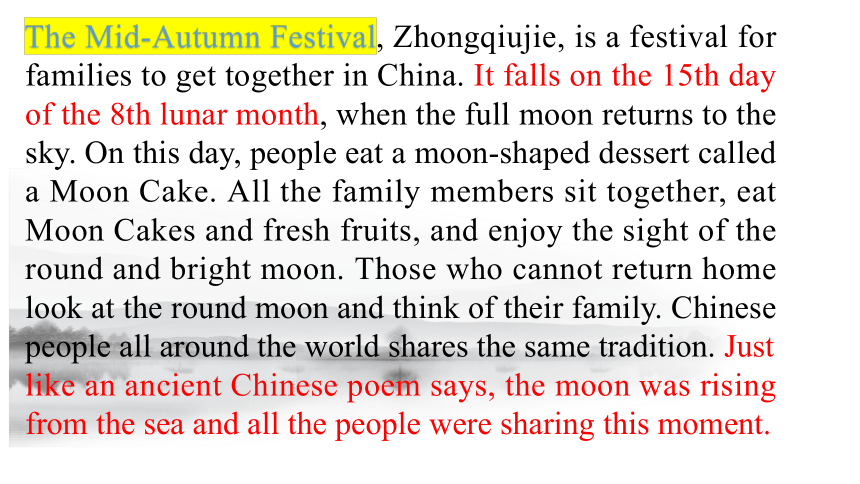
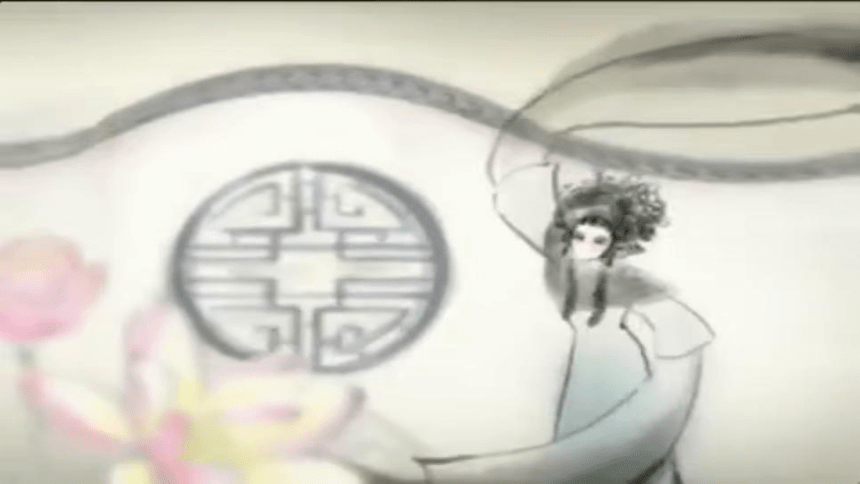
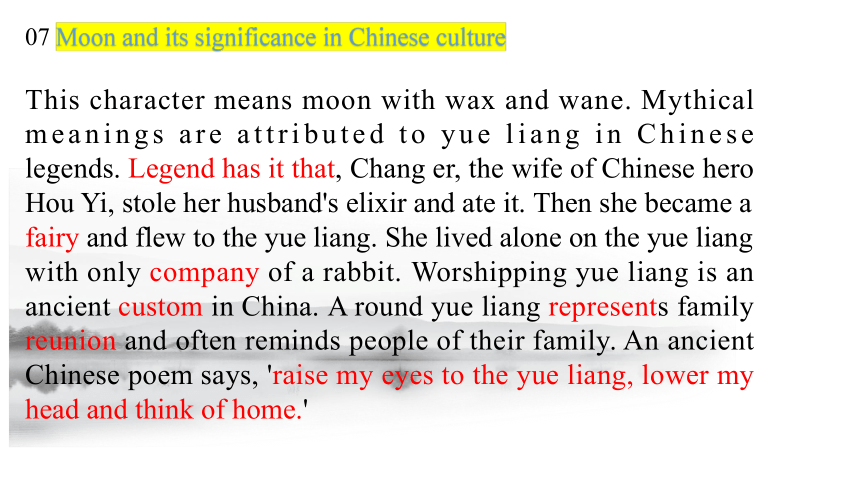

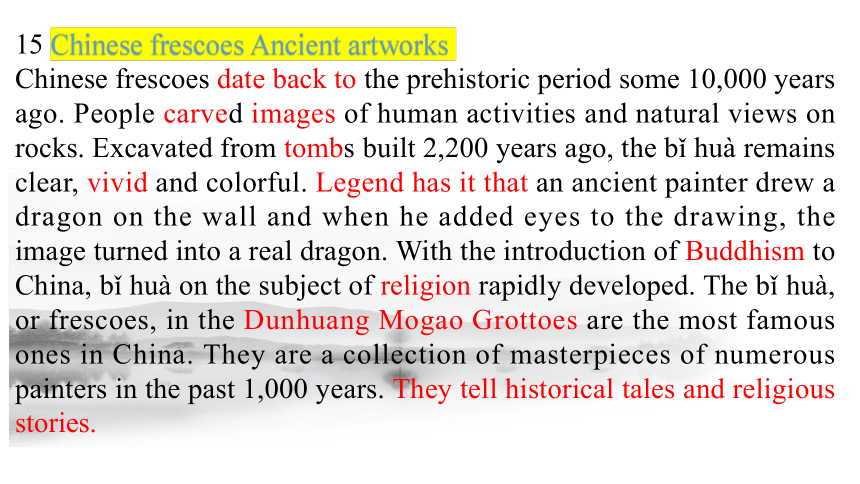
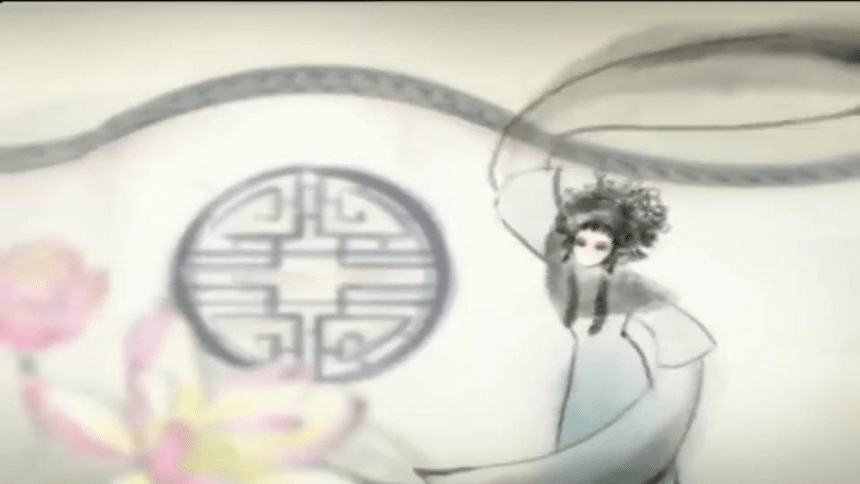
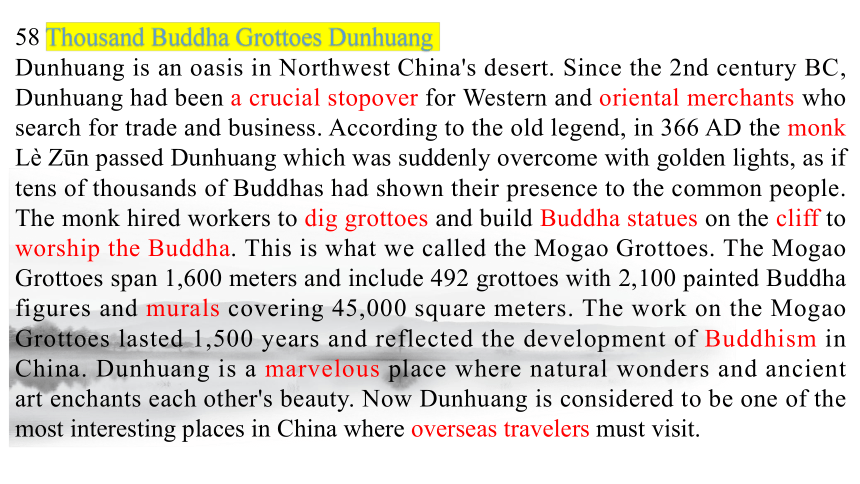
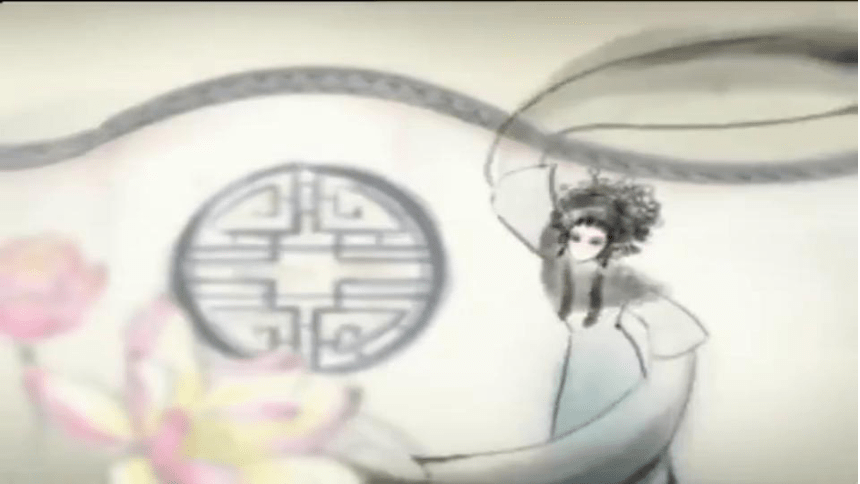
文档简介
(共40张PPT)
Hello,China
Acupuncture and Moxibustion TCM (Hello China )
Acupuncture, which is called zhen jiu in Chinese, is a medical treatment that originated in China. Zhen means needles that pierce one's body. Jiu means moxibustion, a special treatment in traditional Chinese medicine. Plant leaves were once used to smoke certain parts of the human body Traditional Chinese medicine describes the energy flow within the human body as a network. It is called jīngluò. The major nodes on the network are called que wei. or an acupuncture point. Traditional Chinese doctors believethat stimulating the que wei can promote energy circulation and expel illness. For example, having zhen jiu on zu san li can promote digestion and having zhen jiu on nei guan is good for one's heart. Chinese people have been using this medical treatment for thousands of years. The tiny needles reveal the mysteries of human body.
The Mid-Autumn Festival, Zhongqiujie, is a festival for families to get together in China. It falls on the 15th day of the 8th lunar month, when the full moon returns to the sky. On this day, people eat a moon-shaped dessert called a Moon Cake. All the family members sit together, eat Moon Cakes and fresh fruits, and enjoy the sight of the round and bright moon. Those who cannot return home look at the round moon and think of their family. Chinese people all around the world shares the same tradition. Just like an ancient Chinese poem says, the moon was rising from the sea and all the people were sharing this moment.
07 Moon and its significance in Chinese culture
This character means moon with wax and wane. Mythical meanings are attributed to yue liang in Chinese legends. Legend has it that, Chang er, the wife of Chinese hero Hou Yi, stole her husband's elixir and ate it. Then she became a fairy and flew to the yue liang. She lived alone on the yue liang with only company of a rabbit. Worshipping yue liang is an ancient custom in China. A round yue liang represents family reunion and often reminds people of their family. An ancient Chinese poem says, 'raise my eyes to the yue liang, lower my head and think of home.'
15 Chinese frescoes Ancient artworks
Chinese frescoes date back to the prehistoric period some 10,000 years ago. People carved images of human activities and natural views on rocks. Excavated from tombs built 2,200 years ago, the bǐ huà remains clear, vivid and colorful. Legend has it that an ancient painter drew a dragon on the wall and when he added eyes to the drawing, the image turned into a real dragon. With the introduction of Buddhism to China, bǐ huà on the subject of religion rapidly developed. The bǐ huà, or frescoes, in the Dunhuang Mogao Grottoes are the most famous ones in China. They are a collection of masterpieces of numerous painters in the past 1,000 years. They tell historical tales and religious stories.
58 Thousand Buddha Grottoes Dunhuang
Dunhuang is an oasis in Northwest China's desert. Since the 2nd century BC, Dunhuang had been a crucial stopover for Western and oriental merchants who search for trade and business. According to the old legend, in 366 AD the monk Lè Zūn passed Dunhuang which was suddenly overcome with golden lights, as if tens of thousands of Buddhas had shown their presence to the common people. The monk hired workers to dig grottoes and build Buddha statues on the cliff to worship the Buddha. This is what we called the Mogao Grottoes. The Mogao Grottoes span 1,600 meters and include 492 grottoes with 2,100 painted Buddha figures and murals covering 45,000 square meters. The work on the Mogao Grottoes lasted 1,500 years and reflected the development of Buddhism in China. Dunhuang is a marvelous place where natural wonders and ancient art enchants each other's beauty. Now Dunhuang is considered to be one of the most interesting places in China where overseas travelers must visit.
20 Calligraphy The ancient art of expression
Chinese calligraphy (shu fa) refers to writing art and techniques with writing brushes. 1,600 years ago, a boy named Wang Xizhi worked hard at calligraphy. He washed his writing brushes in a pool and the pool turned black. Eventually he became a prominent calligrapher in China. Writing brushes, Chinese inks, rice paper and ink slabs are the basic tools of calligraphy. Proper technique for handling the writing brushes and maintaining the proper angle between the tips of brushes and the paper are required. The structure of each individual character and overall arrangement are both important. Calligraphers have created plenty of masterpieces which have been passed from generation to generation. One of the masterpieces is the "Orchid Pavilion Preface" by Wang Xizhi. Shu fa represents the aesthetic taste and philosophy of Chinese scholars.
21 Chinese writing brush Calligraphy
More than 2,000 years ago, a general returned from hunting and was inspired by the tail of a rabbit. He cut off the tail and stuck it into a bamboo drain, making the first writing brush. The pen holder is made of bamboo or bone, the nib is made hairs from sheep, rabbits or wolves. Unlike other writing tools, it is difficult to write with writing brushes. Writing hàn zì with soft máo b represents oriental philosophy. It is regarded as a method to cultivate the mind and nature, and widely used among scholars. Writing became an art called calligraphy with the birth of máo b . Máo b is a friend of Chinese scholars making records of their knowledge and character.
31 Spring Festival and its colorful traditions
Spring festival is the first day of the Chinese lunar calendar when Chunjie is approaching people are busy purchasing goods, cleaning the house, cooking traditional food, making Spring Festival couplets and hanging spring festival pictures. Having a family dinner is the main activity on Chunjie. Dumplings are essential to the dinner. Dumplings represent reunion and goodwill. The whole family gathers to enjoy quality family time. On Chunjie, Lunar New Year's Day, people in new clothes visit each other and give money to kids to send good wishes. During Chunjie holidays all kinds of celebrations are held, including temple fairs performances and Lantern exhibitions which lasts nearly half a month.
3 Confucius and Chinese philosophy
Born in 551 BC, Confucius, Kong zi, has made the greatest contribution to Chinese culture of anyone in history. Although he was raised in a poor family, he visited famous scholars and learned a lot. He developed his thoughts into a system of philosophy known as Confucianism. Confucianism emphasized self-cultivation, harmonious relationships with each other and respect for the elderly. Friends should be honest to each other. Rulers should make an effort to provide a happy life for people. He was a great teacher as well and promoted education for ordinary people. He traveled around to promote his political thinking but failed. But he never gave up. Kong Zi is a great Chinese spiritual leader. Over the last 2,000 years, his philosophy has continued to influence China and the rest of the world. It is also regarded as the symbol of oriental culture.
04 Sun Tzu The Ultimate Master of War
Sun Tzu, who lived in China during the Spring and Autumn Period, is regarded as the ultimate master of war. His great military work, The Art of War, has been read for more than 2,000 years. Sun Tzu believed that competition between economies and logistics is the nature of war. Only if the nation is prosperous and its people are strong enough will they win the war, otherwise the war will bring huge damages to the nation and people. Gathering information on your enemies is the key to winning wars. The victorious general must be familiar with his enemies just as with himself and direct troops according to the newest situation. The supreme art of war is to subdue the enemy without force. His spirit reminds us that peace is the common objective we should pursue.
05 Lao Tzu Father of Chinese Philosophy
Kong Zi (Confucius), the historical Chinese saint, is considered to be the greatest teacher of China. His teacher was Lao Tzu (Laozi). Kong Zi said that Lao Tzu was a dragon who hid in the clouds. He learned from Lao Tzu all his life but could not understand all his great wisdom. 2,500 years later his work has been translated into many foreign languages. Lao Tzu believed that people should learn from nature and keep a harmonious relationship with nature. Beside a river, Lao Tzu told Kong Zi that a saint should act like flowing water. Water gives life to others but does not fight with others. A saint makes no error and no one hates him. Therefore, he can make great achievements. In China, Lao Tzu is considered the elite of teachers.
33 Dragon Boat Festival and its tragic origins
In ancient time, there was a great poet called Qu Yuan. He couldn't bear the anguish when his mother land was invaded, so he drowned himself in the river. Local residents rode boats to salvage and drop the rice balls into the river to distract the fishes’ attention from Qu’s body. Later people memorialized Qu's patriotism by rowing and making Zongzi on the Dragon Boat Festival, Duanwujie. That's how the tradition of dragon boat racing and eating Zongzi were started. A nation practice on Duanwujie is to put wormwood on the front door to repel evil things. In some places people drink realgar wine and children wear sachet. Now the family gets together on Duanwujie. Nowadays people have a variety of other activities to celebrate this traditional festival.
81 Chinese lantern customs
The lantern, deng long, is the traditional lighting tool of China which also represents merit and joy. The traditional deng long is covered by rice paper with candle burning inside. Lights shine through the gossamer rice paper. Deng long have diverse patterns. People like to decorate deng long and paint beautiful and auspicious designs on them. We light several deng long which symbolize happiness and good luck during the Chinese New Year and enjoy deng long shows with family during the Lantern Festival. Now deng long are still used in all kinds of celebrations. Deng long light the night of festivals. Merit and joy spread into different families by these different lanterns.
#73 Tulou Building
The tǔ lóu building is a special residence in China. Central China was in a state of war in the 10th century. Large numbers of people migrated to the mountainous region in southeast China. They built tǔ lóu with clay and rocks for living and defense. Circles of rooms are enclosed by another circle. Rooms are connected by round corridors. The second floor is used as a granary. The third and fourth floors are used as bedrooms. There are more than 300 rooms in the largest tǔ lóu, which can accommodate more than 800 people. The center of tǔ lóu is the public area with wells and kitchens. Family meetings are held on the axis. People have lived in the tǔ lóu, cooking, washing clothes, and holding ceremonies for ancestor worship in harmony for hundreds of years. Now tǔ lóu are open to the public. You can experience the family love and unsophisticated customs when you pass by the lovely windows.
#51 Terracotta Warriors
There is a saying that you have not been to China if you have not visited the terracotta warriors (bing ma yong). Located to the west of Qi'an, bing ma yong is a collection of the tomb treasures of Qin Shihuang, the first Emperor of China. They were built by hundreds of thousands of men more than 2,000 years ago. Bing ma yong were a copy of Qin Shihuang's powerful army which conquered and unified the Six States. Each warrior was as big and vivid as a real soldier. The facial features, expressions and hairlines of the clay warriors were exact duplicates of real ones. Life-sized war chariots and horses were also made. This army of clay statues is as effective and strong as any real-life military force. When you visit bing ma yong it will remind you of the glorious times of the Qin Dynasty.
#48 Forbidden City Chinese imperial palace
Legends say that there are 10,000 rooms in the palace of the emperor in heaven. The emperor in the real world built a palace with 9,999 and a half rooms to show his respect to the Heavenly Emperor. 600 years ago, 100,000 laborers were engaged in building the palace with 100 million bricks and 200 million tiles. The palace featured vermilion walls and gold-glazed tiles. The palace is open to the public and attracts crowds of tourists to experience royal life.
49 Temple of Heaven
Emperors held annual ceremonies to pray to heaven for a good harvest at the Temple of Heaven, Tiāntán. It was built in Beijing in 1420. Emperors pray to heaven for good harvest. Ancient Chinese believed that Earth was Square and heaven was round. The altars and palaces were built into circles to represent heaven. The southern wall was rectangular to represent Earth. Chinese show their respect to heaven in Tiāntán. The blue-glazed tiles of the imperial vault of heaven represent heaven. The circular mound altar is surrounded by a ring of nine plates, which are also surrounded by multiples of nine plates. It represents the supremacy of heaven. Tiāntán covers an area of 2.7 million square metres, with an orderly arrangement showing Chinese regality.
#47 Great Wall of China An introduction
There is a long, stretching wall in China called the Great Wall, cháng chéng. With a length of more than 5,000 kilometres, cháng chéng was built continuously over more than 2,000 years by Chinese people. The watchtowers would be lit up by torches if a watchman spotted an enemy invasion. Messages could be passed to the military centre from one Watchtower to another. Cháng chéng was expected to protect national peace. Constructing cháng chéng would guard our own territory and we won't infringe on other people's territory. It is not only a brick wall, but also one of the world's greatest historical architectural works.
#46 Welcome to Beijing Chinese capital
The layout of Beijing formed in the 15th century. The imperial palace is the centre of the city's symmetrical layout. The 7.7-kilometre long axis is the symbol of B i jīng. There are grand examples of Chinese architecture, such as the Imperial Palace, the Temple of Heaven and the Great Wall. Traditional folk arts, such as Peking Opera, and traditional foods, such as sugar-coated haws on a stick, and roast duck are famous worldwide. The Olympic Games was held here in 2008. While preserving its traditions, Beijing is becoming more and more open. Welcome to Beijing!
#50 Xi'an Ancient Chinese capital
Located in West China, Xi'an is one of the most notable ancient Chinese cities. More than 3,100 years have passed since it was built. Xi'an is the starting point of the Silk Road. It used to be a commercial hub connecting the west and the Orient during its prosperous period. Xi'an has the largest bell tower, which was built in the Ming Dynasty. The largest collection of ancient stone tablets and the Terracotta Warriors with a history of 2,000 years. Now it is a rapidly developing modern city. Xi'an is an undying city in Chinese culture.
#56 Dujiangyan Irrigation Dam
Around 2200 years ago a governor of Sichuan found that the floods happened frequently in the rainy season and water storage was short during the dry season. Therefore, based on the geographic features of the Minjiang River and without doing any damage to the natural environment, he built a special structure dam. The dam is known as Dujiangyan. Dujiangyan functions to direct water and divert floods and sand. Thanks to the dam the region would no longer be plagued by flooding during the rainy season and water supply will be sufficient in the dry season. Dujiangyan has functioned for more than 2200 years even the earthquake with a magnitude of 7.8 on the Richter scale in 2008 which happened near the dam didn't destroy it. Dujiangyan reflects the idea that the land, water and people can live in harmony.
62 Tanghulu A traditional Chinese snack
These are crystalline sugar-coated haws, tanghulu, which is a favorite winter snack for children in northern China. Legends say that 800 years ago an emperor's concubine was sick and had a poor appetite. A doctor ordered that she eat 10 haws boiled with crystal sugar before dinner. The concubine recovered within half-a-month. Later, the prescription was passed on to ordinary people. People put haws on a stick and dipped them in hot sugar syrup. The syrup turned into a solid coating, like crystals on the haws' surface. It is a delicious and wholesome traditional snack commonly seen in stores and on streets. The haws are tart and the crystal sugar is sweet. The special taste often reminds us of our happy childhoods.
#38 Feng Shui
Feng shui is a mystical knowledge in China. People believe that the basic elements of things on the earth originated from air, water and land. The improvement of feng shui will improve the relationship between humans and nature. Feng shui is widely used in architecture and interior design. Chinese believe that the best houses should be integrated into nature. Water brings vitality and fish bring good luck. These elements determine the quality of feng shui. Feng shui involves medicine, architecture and philosophy. Chinese put emphasis on feng shui and the harmonious relationship between humans and nature. This is feng shui... complicated and mysterious.
#40 Door Gods Menshen
People paste pictures of Door Gods on their doors to avoid bad luck and pray for safety. Legends say that an emperor was harassed by demons. Two generals drove out the demons so the emperor was able to fall asleep. The emperor pasted pictures of these two generals on his door and the demons disappeared. People pray that these heroes will guard them from evil. Menshen signifies the beginning of a new year - they guard the home for Chinese.
#78 Porcelain Ware
When processed correctly, a pile of soil can be turned into an exquisite artwork. Chinaware, cí qì, is a part of daily life in China. The surfaces are decorated with various exquisite patterns. Some are as thin as paper; some are as white as jade; some are as course as pottery; and some are as black as lacquer. This is an extraordinary piece of blue and white porcelain made in the 14th century. It was auctioned at more than 20 million pounds. It is the pride of cí qì. Cí qì is still called China in English.
#79 Jade More valuable than gold
It is difficult to acquire beautiful jade. Only through the delicate procedure of cutting, polishing and carving a piece of unshaped stone can shine. Yù has played an important role in people's lives in China for the last 8,000 years. Seals of emperors were made of yù. Yù is also a popular material for amulets, ornaments and expensive artwork. Yù was featured in the medals of Beijing Olympic Games. Yù represents dignity, holiness and purity. Chinese believe that yù is more valuable than gold.
#77 Chinese silk and its ancient beauty
A kind of insect called a silkworm produces white, raw silk threads. Chinese people collect these raw threads, create yarn and weave them. The silk fabrics are soft, smooth and light. It is the best material used in making dresses. A sī chóu dress 2,000 years old was unearthed in a tomb. It weighs less than 50 grammes and can be put into a matchbox. Westerners cherish Chinese sī chóu. It was introduced to Rome around 100 BC by merchants. The route they travelled is called the Silk pared with other material, sī chóu is more delicate and lighter. The clothes made of sī chóu are the most comfortable. Now sī chóu clothes are prominent in modernfashions. Chinese sī chóu has been world famous for its high quality for thousands of years.
#83 Shadow Puppetry
A long time ago a monarch missed his deceased concubine so much, he got sick. His ministers reproduced the image of the concubine with cloth and put it behind a screen. The monarch could see the shadow of his concubine on the screen. This was the origin of the shadow puppet (pi ying). Pi ying represents interesting stories with lively songs and shadows produced by lights. It is the earliest animated technique in the world. The images are always made of patterned donkey leather sewn with thread. The bodily movements and facial expressions of the puppets are created by bamboo sticks. Pi ying tells stories with traditional methods and is popular all over the world. It features not only interesting stories but also Chinese folk art.
Hello,China
Acupuncture and Moxibustion TCM (Hello China )
Acupuncture, which is called zhen jiu in Chinese, is a medical treatment that originated in China. Zhen means needles that pierce one's body. Jiu means moxibustion, a special treatment in traditional Chinese medicine. Plant leaves were once used to smoke certain parts of the human body Traditional Chinese medicine describes the energy flow within the human body as a network. It is called jīngluò. The major nodes on the network are called que wei. or an acupuncture point. Traditional Chinese doctors believethat stimulating the que wei can promote energy circulation and expel illness. For example, having zhen jiu on zu san li can promote digestion and having zhen jiu on nei guan is good for one's heart. Chinese people have been using this medical treatment for thousands of years. The tiny needles reveal the mysteries of human body.
The Mid-Autumn Festival, Zhongqiujie, is a festival for families to get together in China. It falls on the 15th day of the 8th lunar month, when the full moon returns to the sky. On this day, people eat a moon-shaped dessert called a Moon Cake. All the family members sit together, eat Moon Cakes and fresh fruits, and enjoy the sight of the round and bright moon. Those who cannot return home look at the round moon and think of their family. Chinese people all around the world shares the same tradition. Just like an ancient Chinese poem says, the moon was rising from the sea and all the people were sharing this moment.
07 Moon and its significance in Chinese culture
This character means moon with wax and wane. Mythical meanings are attributed to yue liang in Chinese legends. Legend has it that, Chang er, the wife of Chinese hero Hou Yi, stole her husband's elixir and ate it. Then she became a fairy and flew to the yue liang. She lived alone on the yue liang with only company of a rabbit. Worshipping yue liang is an ancient custom in China. A round yue liang represents family reunion and often reminds people of their family. An ancient Chinese poem says, 'raise my eyes to the yue liang, lower my head and think of home.'
15 Chinese frescoes Ancient artworks
Chinese frescoes date back to the prehistoric period some 10,000 years ago. People carved images of human activities and natural views on rocks. Excavated from tombs built 2,200 years ago, the bǐ huà remains clear, vivid and colorful. Legend has it that an ancient painter drew a dragon on the wall and when he added eyes to the drawing, the image turned into a real dragon. With the introduction of Buddhism to China, bǐ huà on the subject of religion rapidly developed. The bǐ huà, or frescoes, in the Dunhuang Mogao Grottoes are the most famous ones in China. They are a collection of masterpieces of numerous painters in the past 1,000 years. They tell historical tales and religious stories.
58 Thousand Buddha Grottoes Dunhuang
Dunhuang is an oasis in Northwest China's desert. Since the 2nd century BC, Dunhuang had been a crucial stopover for Western and oriental merchants who search for trade and business. According to the old legend, in 366 AD the monk Lè Zūn passed Dunhuang which was suddenly overcome with golden lights, as if tens of thousands of Buddhas had shown their presence to the common people. The monk hired workers to dig grottoes and build Buddha statues on the cliff to worship the Buddha. This is what we called the Mogao Grottoes. The Mogao Grottoes span 1,600 meters and include 492 grottoes with 2,100 painted Buddha figures and murals covering 45,000 square meters. The work on the Mogao Grottoes lasted 1,500 years and reflected the development of Buddhism in China. Dunhuang is a marvelous place where natural wonders and ancient art enchants each other's beauty. Now Dunhuang is considered to be one of the most interesting places in China where overseas travelers must visit.
20 Calligraphy The ancient art of expression
Chinese calligraphy (shu fa) refers to writing art and techniques with writing brushes. 1,600 years ago, a boy named Wang Xizhi worked hard at calligraphy. He washed his writing brushes in a pool and the pool turned black. Eventually he became a prominent calligrapher in China. Writing brushes, Chinese inks, rice paper and ink slabs are the basic tools of calligraphy. Proper technique for handling the writing brushes and maintaining the proper angle between the tips of brushes and the paper are required. The structure of each individual character and overall arrangement are both important. Calligraphers have created plenty of masterpieces which have been passed from generation to generation. One of the masterpieces is the "Orchid Pavilion Preface" by Wang Xizhi. Shu fa represents the aesthetic taste and philosophy of Chinese scholars.
21 Chinese writing brush Calligraphy
More than 2,000 years ago, a general returned from hunting and was inspired by the tail of a rabbit. He cut off the tail and stuck it into a bamboo drain, making the first writing brush. The pen holder is made of bamboo or bone, the nib is made hairs from sheep, rabbits or wolves. Unlike other writing tools, it is difficult to write with writing brushes. Writing hàn zì with soft máo b represents oriental philosophy. It is regarded as a method to cultivate the mind and nature, and widely used among scholars. Writing became an art called calligraphy with the birth of máo b . Máo b is a friend of Chinese scholars making records of their knowledge and character.
31 Spring Festival and its colorful traditions
Spring festival is the first day of the Chinese lunar calendar when Chunjie is approaching people are busy purchasing goods, cleaning the house, cooking traditional food, making Spring Festival couplets and hanging spring festival pictures. Having a family dinner is the main activity on Chunjie. Dumplings are essential to the dinner. Dumplings represent reunion and goodwill. The whole family gathers to enjoy quality family time. On Chunjie, Lunar New Year's Day, people in new clothes visit each other and give money to kids to send good wishes. During Chunjie holidays all kinds of celebrations are held, including temple fairs performances and Lantern exhibitions which lasts nearly half a month.
3 Confucius and Chinese philosophy
Born in 551 BC, Confucius, Kong zi, has made the greatest contribution to Chinese culture of anyone in history. Although he was raised in a poor family, he visited famous scholars and learned a lot. He developed his thoughts into a system of philosophy known as Confucianism. Confucianism emphasized self-cultivation, harmonious relationships with each other and respect for the elderly. Friends should be honest to each other. Rulers should make an effort to provide a happy life for people. He was a great teacher as well and promoted education for ordinary people. He traveled around to promote his political thinking but failed. But he never gave up. Kong Zi is a great Chinese spiritual leader. Over the last 2,000 years, his philosophy has continued to influence China and the rest of the world. It is also regarded as the symbol of oriental culture.
04 Sun Tzu The Ultimate Master of War
Sun Tzu, who lived in China during the Spring and Autumn Period, is regarded as the ultimate master of war. His great military work, The Art of War, has been read for more than 2,000 years. Sun Tzu believed that competition between economies and logistics is the nature of war. Only if the nation is prosperous and its people are strong enough will they win the war, otherwise the war will bring huge damages to the nation and people. Gathering information on your enemies is the key to winning wars. The victorious general must be familiar with his enemies just as with himself and direct troops according to the newest situation. The supreme art of war is to subdue the enemy without force. His spirit reminds us that peace is the common objective we should pursue.
05 Lao Tzu Father of Chinese Philosophy
Kong Zi (Confucius), the historical Chinese saint, is considered to be the greatest teacher of China. His teacher was Lao Tzu (Laozi). Kong Zi said that Lao Tzu was a dragon who hid in the clouds. He learned from Lao Tzu all his life but could not understand all his great wisdom. 2,500 years later his work has been translated into many foreign languages. Lao Tzu believed that people should learn from nature and keep a harmonious relationship with nature. Beside a river, Lao Tzu told Kong Zi that a saint should act like flowing water. Water gives life to others but does not fight with others. A saint makes no error and no one hates him. Therefore, he can make great achievements. In China, Lao Tzu is considered the elite of teachers.
33 Dragon Boat Festival and its tragic origins
In ancient time, there was a great poet called Qu Yuan. He couldn't bear the anguish when his mother land was invaded, so he drowned himself in the river. Local residents rode boats to salvage and drop the rice balls into the river to distract the fishes’ attention from Qu’s body. Later people memorialized Qu's patriotism by rowing and making Zongzi on the Dragon Boat Festival, Duanwujie. That's how the tradition of dragon boat racing and eating Zongzi were started. A nation practice on Duanwujie is to put wormwood on the front door to repel evil things. In some places people drink realgar wine and children wear sachet. Now the family gets together on Duanwujie. Nowadays people have a variety of other activities to celebrate this traditional festival.
81 Chinese lantern customs
The lantern, deng long, is the traditional lighting tool of China which also represents merit and joy. The traditional deng long is covered by rice paper with candle burning inside. Lights shine through the gossamer rice paper. Deng long have diverse patterns. People like to decorate deng long and paint beautiful and auspicious designs on them. We light several deng long which symbolize happiness and good luck during the Chinese New Year and enjoy deng long shows with family during the Lantern Festival. Now deng long are still used in all kinds of celebrations. Deng long light the night of festivals. Merit and joy spread into different families by these different lanterns.
#73 Tulou Building
The tǔ lóu building is a special residence in China. Central China was in a state of war in the 10th century. Large numbers of people migrated to the mountainous region in southeast China. They built tǔ lóu with clay and rocks for living and defense. Circles of rooms are enclosed by another circle. Rooms are connected by round corridors. The second floor is used as a granary. The third and fourth floors are used as bedrooms. There are more than 300 rooms in the largest tǔ lóu, which can accommodate more than 800 people. The center of tǔ lóu is the public area with wells and kitchens. Family meetings are held on the axis. People have lived in the tǔ lóu, cooking, washing clothes, and holding ceremonies for ancestor worship in harmony for hundreds of years. Now tǔ lóu are open to the public. You can experience the family love and unsophisticated customs when you pass by the lovely windows.
#51 Terracotta Warriors
There is a saying that you have not been to China if you have not visited the terracotta warriors (bing ma yong). Located to the west of Qi'an, bing ma yong is a collection of the tomb treasures of Qin Shihuang, the first Emperor of China. They were built by hundreds of thousands of men more than 2,000 years ago. Bing ma yong were a copy of Qin Shihuang's powerful army which conquered and unified the Six States. Each warrior was as big and vivid as a real soldier. The facial features, expressions and hairlines of the clay warriors were exact duplicates of real ones. Life-sized war chariots and horses were also made. This army of clay statues is as effective and strong as any real-life military force. When you visit bing ma yong it will remind you of the glorious times of the Qin Dynasty.
#48 Forbidden City Chinese imperial palace
Legends say that there are 10,000 rooms in the palace of the emperor in heaven. The emperor in the real world built a palace with 9,999 and a half rooms to show his respect to the Heavenly Emperor. 600 years ago, 100,000 laborers were engaged in building the palace with 100 million bricks and 200 million tiles. The palace featured vermilion walls and gold-glazed tiles. The palace is open to the public and attracts crowds of tourists to experience royal life.
49 Temple of Heaven
Emperors held annual ceremonies to pray to heaven for a good harvest at the Temple of Heaven, Tiāntán. It was built in Beijing in 1420. Emperors pray to heaven for good harvest. Ancient Chinese believed that Earth was Square and heaven was round. The altars and palaces were built into circles to represent heaven. The southern wall was rectangular to represent Earth. Chinese show their respect to heaven in Tiāntán. The blue-glazed tiles of the imperial vault of heaven represent heaven. The circular mound altar is surrounded by a ring of nine plates, which are also surrounded by multiples of nine plates. It represents the supremacy of heaven. Tiāntán covers an area of 2.7 million square metres, with an orderly arrangement showing Chinese regality.
#47 Great Wall of China An introduction
There is a long, stretching wall in China called the Great Wall, cháng chéng. With a length of more than 5,000 kilometres, cháng chéng was built continuously over more than 2,000 years by Chinese people. The watchtowers would be lit up by torches if a watchman spotted an enemy invasion. Messages could be passed to the military centre from one Watchtower to another. Cháng chéng was expected to protect national peace. Constructing cháng chéng would guard our own territory and we won't infringe on other people's territory. It is not only a brick wall, but also one of the world's greatest historical architectural works.
#46 Welcome to Beijing Chinese capital
The layout of Beijing formed in the 15th century. The imperial palace is the centre of the city's symmetrical layout. The 7.7-kilometre long axis is the symbol of B i jīng. There are grand examples of Chinese architecture, such as the Imperial Palace, the Temple of Heaven and the Great Wall. Traditional folk arts, such as Peking Opera, and traditional foods, such as sugar-coated haws on a stick, and roast duck are famous worldwide. The Olympic Games was held here in 2008. While preserving its traditions, Beijing is becoming more and more open. Welcome to Beijing!
#50 Xi'an Ancient Chinese capital
Located in West China, Xi'an is one of the most notable ancient Chinese cities. More than 3,100 years have passed since it was built. Xi'an is the starting point of the Silk Road. It used to be a commercial hub connecting the west and the Orient during its prosperous period. Xi'an has the largest bell tower, which was built in the Ming Dynasty. The largest collection of ancient stone tablets and the Terracotta Warriors with a history of 2,000 years. Now it is a rapidly developing modern city. Xi'an is an undying city in Chinese culture.
#56 Dujiangyan Irrigation Dam
Around 2200 years ago a governor of Sichuan found that the floods happened frequently in the rainy season and water storage was short during the dry season. Therefore, based on the geographic features of the Minjiang River and without doing any damage to the natural environment, he built a special structure dam. The dam is known as Dujiangyan. Dujiangyan functions to direct water and divert floods and sand. Thanks to the dam the region would no longer be plagued by flooding during the rainy season and water supply will be sufficient in the dry season. Dujiangyan has functioned for more than 2200 years even the earthquake with a magnitude of 7.8 on the Richter scale in 2008 which happened near the dam didn't destroy it. Dujiangyan reflects the idea that the land, water and people can live in harmony.
62 Tanghulu A traditional Chinese snack
These are crystalline sugar-coated haws, tanghulu, which is a favorite winter snack for children in northern China. Legends say that 800 years ago an emperor's concubine was sick and had a poor appetite. A doctor ordered that she eat 10 haws boiled with crystal sugar before dinner. The concubine recovered within half-a-month. Later, the prescription was passed on to ordinary people. People put haws on a stick and dipped them in hot sugar syrup. The syrup turned into a solid coating, like crystals on the haws' surface. It is a delicious and wholesome traditional snack commonly seen in stores and on streets. The haws are tart and the crystal sugar is sweet. The special taste often reminds us of our happy childhoods.
#38 Feng Shui
Feng shui is a mystical knowledge in China. People believe that the basic elements of things on the earth originated from air, water and land. The improvement of feng shui will improve the relationship between humans and nature. Feng shui is widely used in architecture and interior design. Chinese believe that the best houses should be integrated into nature. Water brings vitality and fish bring good luck. These elements determine the quality of feng shui. Feng shui involves medicine, architecture and philosophy. Chinese put emphasis on feng shui and the harmonious relationship between humans and nature. This is feng shui... complicated and mysterious.
#40 Door Gods Menshen
People paste pictures of Door Gods on their doors to avoid bad luck and pray for safety. Legends say that an emperor was harassed by demons. Two generals drove out the demons so the emperor was able to fall asleep. The emperor pasted pictures of these two generals on his door and the demons disappeared. People pray that these heroes will guard them from evil. Menshen signifies the beginning of a new year - they guard the home for Chinese.
#78 Porcelain Ware
When processed correctly, a pile of soil can be turned into an exquisite artwork. Chinaware, cí qì, is a part of daily life in China. The surfaces are decorated with various exquisite patterns. Some are as thin as paper; some are as white as jade; some are as course as pottery; and some are as black as lacquer. This is an extraordinary piece of blue and white porcelain made in the 14th century. It was auctioned at more than 20 million pounds. It is the pride of cí qì. Cí qì is still called China in English.
#79 Jade More valuable than gold
It is difficult to acquire beautiful jade. Only through the delicate procedure of cutting, polishing and carving a piece of unshaped stone can shine. Yù has played an important role in people's lives in China for the last 8,000 years. Seals of emperors were made of yù. Yù is also a popular material for amulets, ornaments and expensive artwork. Yù was featured in the medals of Beijing Olympic Games. Yù represents dignity, holiness and purity. Chinese believe that yù is more valuable than gold.
#77 Chinese silk and its ancient beauty
A kind of insect called a silkworm produces white, raw silk threads. Chinese people collect these raw threads, create yarn and weave them. The silk fabrics are soft, smooth and light. It is the best material used in making dresses. A sī chóu dress 2,000 years old was unearthed in a tomb. It weighs less than 50 grammes and can be put into a matchbox. Westerners cherish Chinese sī chóu. It was introduced to Rome around 100 BC by merchants. The route they travelled is called the Silk pared with other material, sī chóu is more delicate and lighter. The clothes made of sī chóu are the most comfortable. Now sī chóu clothes are prominent in modernfashions. Chinese sī chóu has been world famous for its high quality for thousands of years.
#83 Shadow Puppetry
A long time ago a monarch missed his deceased concubine so much, he got sick. His ministers reproduced the image of the concubine with cloth and put it behind a screen. The monarch could see the shadow of his concubine on the screen. This was the origin of the shadow puppet (pi ying). Pi ying represents interesting stories with lively songs and shadows produced by lights. It is the earliest animated technique in the world. The images are always made of patterned donkey leather sewn with thread. The bodily movements and facial expressions of the puppets are created by bamboo sticks. Pi ying tells stories with traditional methods and is popular all over the world. It features not only interesting stories but also Chinese folk art.
